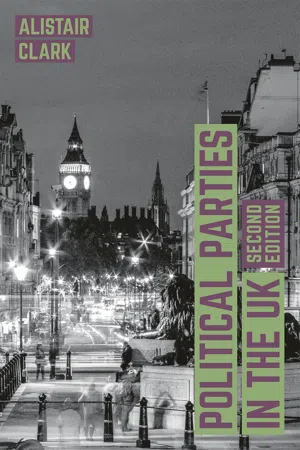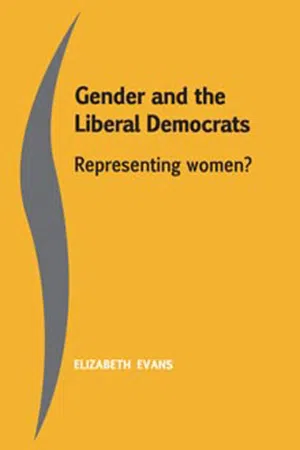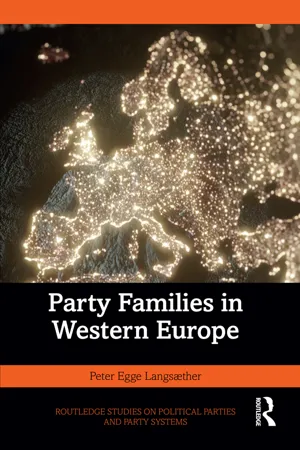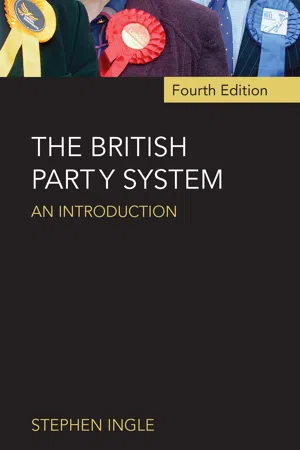Politics & International Relations
Liberal Democrats
The Liberal Democrats are a centrist political party in the United Kingdom. They advocate for civil liberties, social liberalism, and electoral reform. The party has historically supported policies such as environmental protection, human rights, and a pro-European Union stance.
Written by Perlego with AI-assistance
Related key terms
Related key terms
1 of 4
Related key terms
1 of 3
5 Key excerpts on "Liberal Democrats"
- eBook - ePub
- Alistair Clark(Author)
- 2018(Publication Date)
- Bloomsbury Academic(Publisher)
5 THE LIBERAL DEMOCRATSThe Liberal Democrats (and predecessors) were for a long time the third party in the Westminster party system. The party won 62 seats in 2005, and 57 seats in the 2010 parliament. This was achieved by taking seats from both Labour and the Conservatives, and by being able to exploit popular issues not represented by the two main parties, for instance in opposing the 2003 Iraq war. Nevertheless, their ascent was not problem free and variously involved the perception of internal ideological and policy conflict, and some high-profile changes of leadership. The party’s development peaked with participation in the 2010–2015 coalition government as junior partner to the Conservative Party. The experience of government proved near fatal for the Liberal Democrats. The party was reduced to a rump of eight MPs in the 2015 general election, and only rose to 12 in 2017 after a lacklustre campaign.This chapter therefore examines developments in the Liberal Democrats. The first section sets out the key elements of Liberal Democrat ideology and policy through the lens of the two main ideological strands in the party, classical liberalism and more interventionist social liberalism. The second section evaluates the leadership of the party, and outlines the party’s procedures for selecting a leader. The third section sets out the party’s candidate selection processes and assesses how representative the party’s MPs are. Post-2010, the Liberal Democrats could add coalition government alongside the Conservatives at Westminster to their record of holding office in the devolved institutions. The final section therefore evaluates the party’s record in office.Ideology and PolicyLiberalism has long ideological roots. All variants of liberalism ultimately aim to achieve individual liberty or freedom. Two main strands are traditionally identified: classical liberalism and social liberalism . Both can be traced in the ideological and policy approach of the Liberal Democrats. The primary concern of classical liberalism - eBook - ePub
Electoral Pledges in Britain Since 1918
The Politics of Promises
- David Thackeray, Richard Toye, David Thackeray, Richard Toye, David Thackeray, Richard Toye(Authors)
- 2020(Publication Date)
- Palgrave Macmillan(Publisher)
4 The party needed a popularly-held understanding of what they stood for if they were to be electorally successful in the longer term–in short, a less ephemeral sense of the ‘promise of Liberal Democracy’.This chapter surveys that promise (or lack thereof) from the foundation of the SDP to the arrival of the coalition government. In that period the Liberal Democrats came into being as a political force, and established themselves as the third party at Westminster, growing incrementally in parliamentary representation until 2006, before entering government in coalition with the Conservatives in 2010 and suffering a consequent electoral backlash.5 In 2015 the Liberal Democrats were reduced to just eight seats at Westminster, losing their status as the third party.6 While they enjoyed a slight recovery in terms of seats (rising to twelve MPs), this was accompanied by further declines in both the Liberal Democrats’ share of the vote and in the number of votes cast for the party.7 The central question which the chapter seeks to address then is the extent to which the new party was able to develop a coherent and popularly-understood ‘promise’ of Liberal Democracy. This is a question of profound significance for understanding the development of the party and its successes and failures—as protagonists such as Beith knew at the time. Implicit in some political science explanations of the development of the Liberal Democrats is a teleological emphasis on ‘professionalisation’ and ‘maturity’, which Emma Sanderson -Nash argues was integral to the Liberal Democrats being able to take office in 2010.8 Such narratives are typically framed in a conventional political science paradigm which regards the politics of the 1990s as normative, and which has recently come under heavy criticism.9 This is not to say that actors did not themselves regard the politics of the 1990s as normative—this was certainly true of Nick Clegg and his ‘new generation’ of Liberal Democrats - eBook - ePub
Gender and the Liberal Democrats
Representing women
- Elizabeth Evans(Author)
- 2013(Publication Date)
- Manchester University Press(Publisher)
This introductory chapter establishes both the national and international context within which the themes of this book – the descriptive, substantive and symbolic representation of women by the Liberal Democrats – are examined. As such, it addresses five key areas: it provides a brief overview of the Liberal Democrats in respect of contemporary electoral politics in the UK; considers inter-party comparisons of women’s representation; situates this research within an international context by comparing the number and percentage of women Liberal Democrat MPs with other European Liberal parties; outlines the main contentions of the research; and finally explores the various approaches to the concept of representation that underpin this study.The Liberal Democrats
The 2010 general election proved a decisive turning point for the party. Despite a reduction in the overall number of MPs returned, the party were in the position of helping determine the make-up of the next government. Following detailed negotiations, the party entered a coalition government with the Conservatives which saw Liberal Democrats take up five positions in the Cabinet, with Nick Clegg as Deputy Prime Minister. Notwithstanding their position as coalition partners and securing their highest national share of the vote (23 percent) in the 2010 general election, the Liberal Democrats are still struggling to make the electoral breakthrough that many have long anticipated (Dorey and Denham, 2007).The televised leaders’ debates offered a new and important opportunity for the third party to compete on a level playing field during the 2010 general election. Nick Clegg’s success during the debates, which at its peak resulted in opinion polling of over 30 percent for the party, was not eventually translated into seats. Although the party managed to secure the support of the Observer and Guardian , the Conservative-supporting press, notably the Sun - eBook - ePub
- Peter Egge Langsæther(Author)
- 2023(Publication Date)
- Routledge(Publisher)
FDP. Die Liberalen (FDP) FDP. The Liberals - UK Liberal Democrats (Lib Dems) Liberal Democrats Social Democratic (origins)As is clear, names would not be a very good indicator for Liberal party family belonging. While a few parties do explicitly mention liberalism in their party names, most do not. Some use democrat in their name instead. But there are also parties calling themselves the Centre, the Left, and even – somewhat confusingly – the Radical Left. International affiliations would capture most (but not all) of the parties here. And until the 2019 EP election, LREM would not be counted as Liberal as it was unaffiliated with ALDE. In June 2019, it merged with LREM and renamed itself Renew Europe (Mudde 2019 ). Furthermore, several of the parties found to present political programs inconsistent with liberal ideologies would be included in the party family on account of their international affiliations. The reclassifications performed here based on ideological criteria and CHES data do reduce the heterogeneity of the party family, making it a more coherent classification category.6.4 The power of the Liberal parties
The average electoral support for the parties in Table 6.1 has been very stable at around 7–8% up until recently. Support rose somewhat in 2016–2020 to an average of 10.3%, much due to the rise of Macron’s LREM. However, there is ample cross-country variation in this regard (see Figure 6.4 ). In the Netherlands, the Democraten 66 (D66) have done very well in the last decade (Aarts and van der Kolk 2011 ; van Holsteyn 2014 , 2018 ). Spain, a country with very weak traditions for Liberal parties, witnessed the foundation of two new Liberal parties, the Ciudadanos (Cs) and the Unión Progreso y Democracia (UPD). However, while the latter turned out to be rather short-lived, Cs has established itself as an important party in the Spanish system (Nuñes 2019) . In the 2015 and 2016 elections, which were marked by antipathy towards the two established parties, Cs obtained more than 13% of the vote (Lancaster 2017 ) which further increased to 15.9% in the 2019 election. However, a second election was called as no coalition government could successfully be formed, and Cs fell to a disastrous 6.8%. Early analyses suggest that they lost votes primarily to the Conservative Partido Popular and the young Radical Right party Vox, partly for reasons related to the economy and partly because some of these voters wanted a tougher stance on the issue of Catalan independence (Rodon 2020 - eBook - ePub
The British Party System
An introduction
- Stephen Ingle(Author)
- 2008(Publication Date)
- Routledge(Publisher)
Worse was to follow in 1950: only nine Liberals were elected and no fewer than 319 deposits were lost. In 1951 and again in 1955, six Liberals sat in the House of Commons, representing only 1 per cent of voters. The ‘strange death of Liberal England’ seemed almost complete. But only almost. As the Conservative governments of Eden and later Macmillan became unpopular, so the Liberals showed small signs of recovery. Derided as a Celtic fringe party, they broke out of their familiar territory with a spectacular by-election victory over the Conservatives in the safe London suburban seat of Orpington. The Conservative vote fell by 18 per cent and the Liberal vote increased by an unprecedented 31 per cent. It was the most stunning of all such victories. For the next thirty-five years the Liberals and their successors would garner protest votes with assiduity and increasing tactical nous, usually from unpopular Conservative governments. They were often dismissed by their opponents as ideological scavengers – feeding off the votes of the disgruntled, rather than representing something that might be called a Liberal tradition – but they could not be ignored.Liberal ideology
Liberalism has a long and on the whole honourable history in British parliamentary politics. Drawing from the philosophical traditions that originally gave them political shape, the Whigs and later the Liberals were concerned with the nature and practices of the constitution. Although in many other respects Liberalism can be seen to have changed over the years, with Manchester Liberalism and Lloyd Georgian Liberalism exhibiting almost polar-opposite economic policies for example, a concern with the protection and enhancement of civil liberties through the constitution has been constant.6 And this tradition has marked modern Liberalism and Liberal Democracy just as clearly as it marked the Liberal Party of Jo Grimond, setting it apart from the Conservatives for whom constitutional issues were taken as more or less settled, and the Labour Party, which traditionally sought a strong central state capable of creating and managing socialism.Constitutional reform is not the only debt that Liberal Democrats owe to their tradition. They have also been shaped by the forces that emerged in the 1890s. The political currents of the late Victorian period included three distinct but generic traditions on the centre left: the radical liberal, the social democratic and the fundamentalist socialist; distinct but not separate because of overlapping support. There was a fluidity regarding political allegiances at the time with new groups forming and reforming almost continuously.7 There were, for example, the ‘new Liberals’, who claimed to speak in the interests of the industrial working class. They argued strongly that the state ought to be prepared to intervene in the economy in the interests of the individual liberties of all citizens. About the same time as the new Liberals were changing the contours of liberalism, socialism was beginning to establish itself. There was much in common between the movements, not least the friendship between the leading members. Collaborative groups of intellectuals were established, such as the Rainbow Circle.8 The liberal magazine The Nation, declaring that left-wing liberalism merged imperceptibly into socialism, believed that the progressive agenda would be set by adherents to a broad left-of-centre platform that it called social democracy.9
Index pages curate the most relevant extracts from our library of academic textbooks. They’ve been created using an in-house natural language model (NLM), each adding context and meaning to key research topics.
Explore more topic indexes
Explore more topic indexes
1 of 6
Explore more topic indexes
1 of 4




